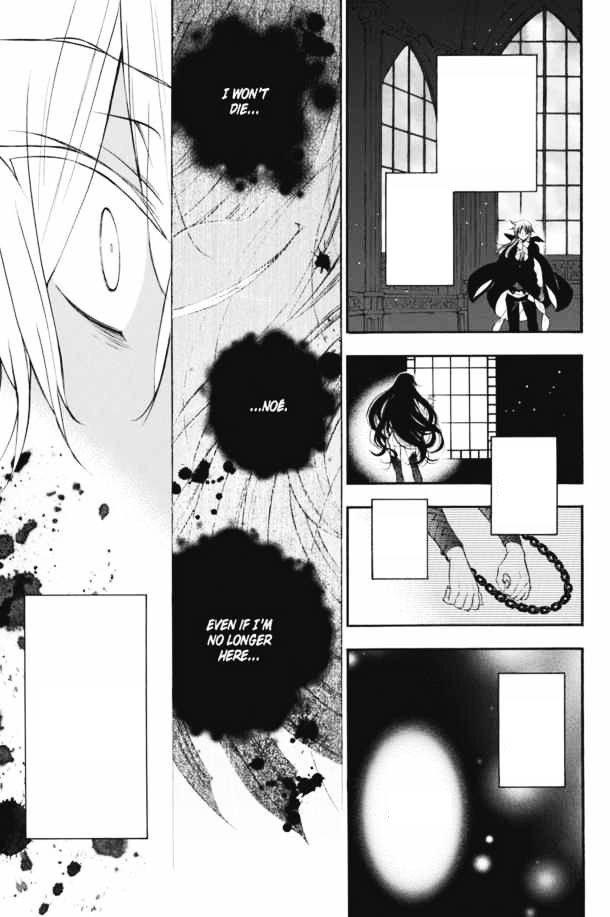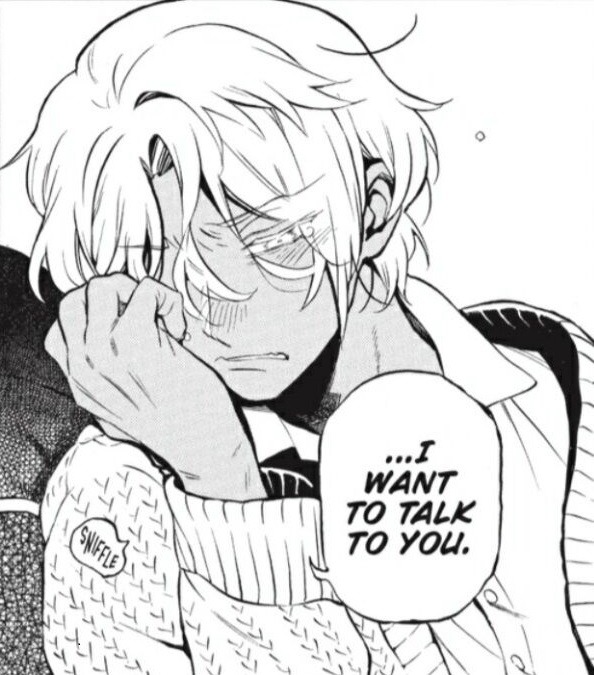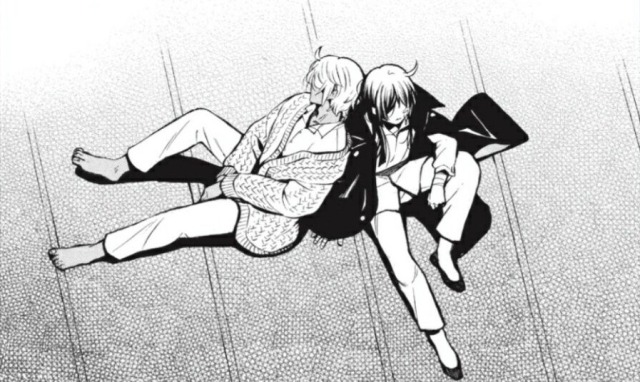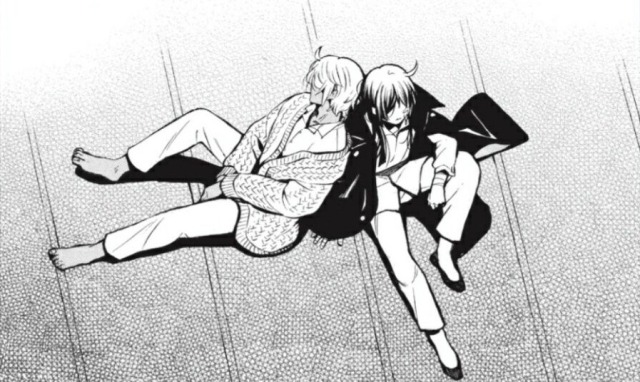#noé arqueueviste
So since my very first read of VnC, one thing has been haunting me, and that’s the dhampirs’ names.
Lots of VnC characters’ names are references, and with every character but the dhams, it’s immediately obvious why the references are there. Veronica de Sade is a sadist. Doctor Moreau is a mad scientist. Jean Chastel was a real-world hunter that claimed to shoot the beast of Gévaudan. None of this is exactly subtle.
And then we have the dhams.
The dhampirs’ names are all references to Dante’s divine comedy. Dante is the author and narrator, Riche is short for Beatrice—Dante’s guide through Paradise, and Johann was the name of Dante Alighieri’s first publisher. But what do the dhampirs have to do with the story of a poet being given a tour of heaven and hell?
For ages I’ve been assuming that we’d have to wait for some future event to make the Divine Comedy reference relevant, but today an alternate explanation finally hit me, and now I’m wondering if Mochijun might be playing on the idea of guides. Because Dante is the closest the closest thing Vanitas and Noé have to a guide through this world of curse bearers that they work in.
The Divine Comedy is famous because it’s the poem that brought structure to the afterlife. It’s the origin of the levels of hell that are referenced so often in pop culture. It is, especially in Inferno, a work that brings order to chaos. It’s also a work that centers around the idea of guides, with three different guide figures appearing at different points to guide Dante on his journey through the afterlife.
Dante might not be a literal guide, but he is, in a very real way, shaping the direction of Vanitas’s revenge quest, because he’s his information broker. He’s the one that tells him about the beast of Gévaudan, about where to find the nine-fold murderer, and about the Chasseurs’ connection to the vampire abductions. Curse bearers are an inherently hard to track phenomenon, with Naenia seemingly popping up at random all over both worlds, but Dante’s always there to tell Vanitas where to go.
The dhams, with Dante at the head, are Vanitas and Noé’s very own trio of guides, just like in the poem about a trio of guides that their names come from.
Y'know, if Noé continues down the path of becoming adversarial to teacher, it’s quite possible that teacher and/or the rest of the de Sades might decide to cut him off. We know he has money in the bank from the de Sades, and some access to vampire high society through Dominique, but I wonder how easy it would be for him to be cut off from all that.
I also wonder, if the de Sades found out that Noé has turned against their father/grandfather, whether they might try to cut him off from Dominique. I can totally see a future where Domi is forced to choose between supporting Noé vs teacher or staying with her family, and though that should be an easy choice, abuse does funny things to people, and I’m curious how hard it might be for her to leave.
Or alternatively, there’s also the incredibly creepy option where none of this happens. If Noé fully turns against teacher, and teacher doesn’t cut him off, how long do you think it’d take Noé to notice that that’s wrong?
It feels totally in-character to me for teacher to continue supporting Noé financially even as he fights to stop him, since he seems to view Noé much more as an amusement than a serious threat, and there’s something rather unnerving about that.


So I was rereading chapter 4, and uh, this little lie of Vanitas’s gets a lotmore uncomfortable given the new info we got in 55.5.

It’s so interesting to me how there’s certain things that Vanitas is quite sensitive about and does not want to discuss, unless he can turn that discussion into theater and weaponize it against those around him.
Like, the most obvious example of this is his speech at the bal masqué, but he’s totally doing the same thing here. He parades his desire for revenge as part of his introduction speech to the vampires, then lies about not really wanting revenge when Noé asks him about it in the morning, because the truth is his vengeance is a sensitive subject.
Here, meanwhile, he’s weaponizing the fact that nobody else knows what it means to be the kin of the blue moon. We know that the loss of his humanity is an incrediblyvulnerable thing for Vanitas, and something that he avoids bringing up to anyone for as long as possible, and yet here he is referencing that very idea. He can’t admit that he really is being made into something inhuman by his use of the book, but he can lie about having a powerful, presumably inhuman “true form” due to his kinship with Luna, because that’s what will win him this fight. He just has to turn up the false theatricality to eleven in order to say it.
What he says here is really quite close to the sensitive truth, but he’s fine, because it’s all part of the act.
Not to go trying to make VnC into Moulin Rouge again, but I’m thinking a lot about young men in Paris with lost loves and stories to tell and how it all fits into Vanitas and Noé.
Vanitas is going to die. He’s a living reminder of death. He’s been doomed since chapter one. But, though this technically hasn’t been confirmed, I’m certain that Noé is using the written story of him and Vanitas as a form of preservation.
Along with that idea, I think about this line from mémoire 1 way too often:

Because, unless future context majorly changes the meaning here, I’d like to think that will Vanitas accepting Noé’s method of preserving him.
His death is going to be tragic no matter what, but if Noé drinks his blood, if he comes to know him totally, his memory will be preserved as best as it possibly could be. And though it’s a mushy idea, I’d like to think that maybe Vanitas and Noé can both take just a small bit of comfort in the idea that, even after his death, a part of him will live on with Noé. And by writing the story down, Noé can make that preservation permanent.

This panel looks so much like something out of a shoujo lmao
I’ve been thinking more about the visual parallel between the leans in chapters 55.5 and 18, and there’s one difference between them that really stands out to me.


Though it’s a small change, I think it’s really significant that this time, Vanitas is the one supporting Noé.
After the catacombs, this scene marks a shift in their relationship, and Vanitas laying against Noé shows how he’s finally beginning to place a little trust in him. He’s accepted Noé’s insistence on staying beside him, and after “not yet,” he’s beginning to see that Noé could even be a support system sometimes. Thus, in a moment of exhaustion and weakness, he’s using him for physical support.
However, though this is a nice first show of vulnerability from Vanitas, it’s not exactly a comfortable moment for Noé. The fact that Vani leans on him is clearly a shock, and up until this moment, he’s been sitting and worrying about whether it’s okay to ask Vanitas about his past. Their connection is budding here, but it’s unstable, and Noé is quite aware of that instability. He’s treading on eggshells to try and make sure he doesn’t hurt his friend.
Compare that to how Noé acts in 55.5.
As soon as Misha leaves, before Vanitas has said a word about their fight the night before, Noé collapses against Vani’s back. Vanitas even protests as he does so, but Noé needs support and to be close to him in that moment, so he leans. Their relationship is so strong by the end of the storm that, even without having talked things out yet, Noé knows on some level that he can count on Vanitas supporting him. Gone are the eggshells.
It’s not that Noé never has to be careful with Vanitas anymore, but their relationship has become fundamentally more reciprocal than it was in the catacombs. Vanitas has begun to do his share of helping and supporting Noé, and has let slip that he really truly does care about him, so Noé knows he can lean on him physically as well.
We’ve gone from Noé being Vanitas’s stubborn, unwanted tagalong supporter to them being a partnership of equals that can each count on the other when they need to, and it’s really nice to see.



Mochijun said you will consider the intimacy of leaning back to back against a loved one
It just hit me as I was writing another post that, for narrative purposes, Vanitas essentially functions as the curse-bearer in the amusement park arc.
With the exception of the first battle with Jeanne and the amusement park, every story arc in VnC so far features the salvation of a curse-bearer as a key (usually climactic) moment. The little girl Catherine’s salvation causes Vanitas and Noé’s “what is salvation” argument and Veronica’s final ambush at the bal masque. Chloé’s salvation is the big cathartic moment at the end of Gévaudan. And even in the catacombs arc, where most of the story doesn’t concern curse-bearers at all, Vani and Noé still finish the final confrontation by saving the shadow in Moreau’s lab.
Beginning with Amelia in chapter 1, if a story arc ends in a big, cathartic moment of healing as its climax (and they usually do), then you can bet there’s a curse bearer involved. This holds true in every case, except for in the amusement park.
Instead, the amusement park’s climax is a big, cathartic moment of healing/returning to self not for a curse-bearer, but for Vanitas. Just like Vanitas and Noé leaping into Prédateur’s mouth or Jeanne and Jean-Jacques pulling Chloé from her cage, Noé makes a leap of faith when he lets Vanitas fall onto him with knife in hand, and Vanitas is cured as a result. He doesn’t need his true name returned, but he’s snapped out of his hypnosis by Noé’s words as they fall, shedding a violent false self in the process.
Furthermore, in every arc, there’s a moment where a main character has to make a choice and face the current story’s major lesson in order to save the curse-bearer of the day. Vanitas’s mercy killing Catherine forces Noé to confront his rose-colored worldview during the bal masqué. Noé’s insistence on saving Prédateur in the catacombs forces Vanitas to learn that sometimes hopeless-looking situations have a way out after all. Jeanne has to confront a decision with no right answer and choose selfishness in order to save Chloé in Gévaudan. Not only does the curing/salvation of a curse-bearer mark the narrative climax; the very act of saving them offers a distillation of the current arc’s themes.
So what does Noé have to do to bring Vanitas to his senses in the park? In the story arc where Domi nearly kills herself because she misunderstands what Noé wants, in the story arc where Misha nearly destroys everything because he ignores what Vanitas wants for himself, Noé has to stop, reassess, and look at Vanitas clearly. So much of the amusement park arc is about the pain caused when you falsely assume you know how your loved one feels, and it’s only once Noé sets his assumptions aside and seeks to understand Vanitas as he honestly is that he can save him from himself and break his hypnosis. It’s the same kind of narrative distillation.
The task of bringing Vanitas back to himself drives Noé’s growth in this arc the exact same way that the task of saving curse bearers drives character growth in previous chapters. I don’t think Vanitas has been fully saved in the grand scheme of things, but his return to his senses in the park functions undeniably like any other arc’s moment of salvation.
It’s really interesting to me that every major battle with a curse-bearer has that curse-bearer’s salvation as the big turning point/climax in its given story arc, except for the case of the little girl Catherine at the bal masqué, and that’s also the only case where her very salvation is in doubt.
For Amelia, the boy in Moreau’s lab, and Chloé, their stories can move safely toward resolution once they’ve been saved. Their problem has been inarguably solved, so Noé’s narrative retelling of them can wrap itself up, no questions asked.
For Catherine, though, Noé sees things very differently. He rejects the idea that her death could be a salvation when he sees it happen, and even if his idea of what salvation is has changed by the time he’s writing his mémoire, I doubt that moment will ever be a clean or comfortable memory for him. Catherine is the one curse-bearer that he can’t understand Vanitas as having saved, and as a result, her narrative has to be different than the others’. Her salvation comes at a strange and uncomfortable point in the narrative structure of the bal masque. She’s not the climax at all, but dark piece of rising action, unsteadying Noé and Vani before the real climax (Veronica’s ambush) makes its appearance.
I don’t know if this is intentional on MochiJun’s part or not, but it’s really cool that the one time the formula of salvation=climax breaks down is also the one time that, in Noé’s eyes at least, Vanitas’s salvation itself also fails.
